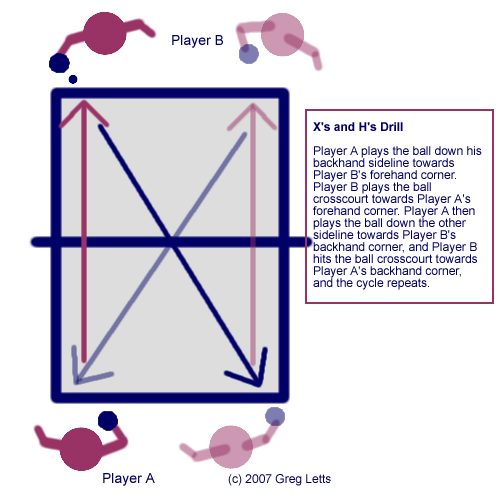
The X’s and H’s drill is one that most table tennis players will probably have performed at some point in their training.
Performing the Drill
As mentioned in the diagram, Player A plays the ball down the sidelines, while Player B hits the ball crosscourt. Simple, isn’t it? But even with a simple drill like this one, there are still ways to get more out of the drill than if you just go through the motions without thinking.
Counterhitting
If both Player A and Player B counterhit the ball, the drill becomes an excellent footwork and stamina drill, where moderately competent players can keep each rally going for a long time, provided that Player B (who is hitting crosscourt, which is the easier role) ensures that the ball is just within Player A’s reach with good footwork. If Player A is struggling to reach the ball, a smart Player B will hit the next ball at a slightly easier location, allowing Player A to regain his balance and composure, and extending the rally. The idea is to put pressure on each other, but not so much pressure that the point ends too quickly.
Blocking vs Looping
If Player A is blocking and Player B is looping, this drill is an excellent chance for Player B to practice looping to Player A’s wide forehand and backhand, a stroke which is not generally practiced enough. The key here is for Player B to start looping crosscourt without too much width, and slowly widen the angle, while allowing Player A time to adjust to the placement of the ball. If Player A is struggling to reach the ball in time, Player B can either reduce the angles, or loop with more spin and less speed, giving Player A more time to move.
If Player A is looping and Player B is blocking, Player B is able to make Player A work very hard, since Player B will be able to block with wide angles. Again, Player B should start with smaller angles, and slowly increase them, keeping Player A under pressure but not making it impossible for Player A to reach the ball. Also, if Player A is finding it hard to reach the ball, he can loop with more spin and less speed, giving him more time to recover and move to the next location.
Looping vs Looping
This is a tough version of the drill, since it is hard to be consistent when looping and relooping. Both players need to concentrate on fast footwork and accurate placement of the ball to make this drill work at all. Even then it’s unlikely that many rallies will last more than 5 or 6 strokes. For advanced players only.

